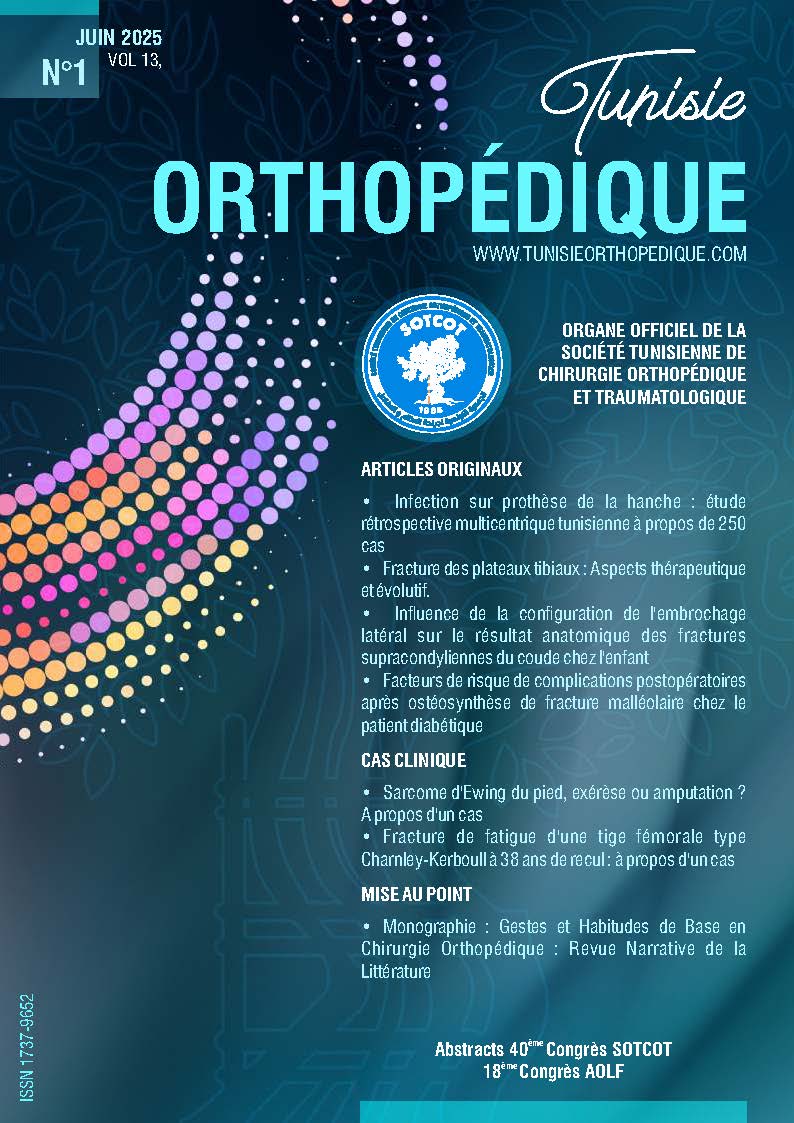Sarcome d’Ewing du pied, exérèse ou amputation ? A propos d’un cas
Keywords:
Mots clé : Ewing- tumeur maligne- pied. , Keywords: Ewing- malignant tumor- footAbstract
Abstract
Ewing's sarcoma is a malignant tumor occurring in 90% of cases before the age of 30. It more often affects the lower limb than the upper limb. We report a case of Ewing's sarcoma localized to the foot in a 9-year-old girl. The treatment consisted of neoadjuvant chemotherapy followed by wide excision of the tumor and reconstruction by non-vascularized fibula, then adjuvant chemotherapy. The final anatomopathological examination found negative surgical margins with a good response to chemotherapy. Complementary radiotherapy was performed with good clinical and radiological evolution. Ewing's sarcoma of the foot is rare. Conservative oncological surgical excision gives good results if it is preceded by chemotherapy and it is better accepted by patients with a satisfactory functional result.
Résumé
Résumé
Le sarcome d’Ewing est une tumeur maligne survenant dans 90 % des cas avant 30 ans. Il concerne plus souvent le membre inférieur que le membre supérieur. Nous rapportons un cas de sarcome d’Ewing localisé au niveau du pied chez une fille âgée de 9 ans. Le traitement a consisté en une chimiothérapie néoadjuvante suivie d’une exérèse large de la tumeur et reconstruction par péroné non vascularisé puis d’une chimiothérapie adjuvante. L’examen anatomopathologique final a retrouvé des limites chirurgicales saines et une bonne réponse à la chimiothérapie. Une radiothérapie complémentaire a été réalisée avec une bonne évolution clinique et radiologique. Le sarcome d’Ewing du pied est rare. L’exérèse chirurgicale carcinologique conservatrice donne de bons résultats si elle est précédée d’une chimiothérapie et elle est mieux acceptée par les patients avec un résultat fonctionnel satisfaisant.
References
[1] Adkins CD, Kitaoka HB, Seidl RK, Pritchard DJ .Ewing’s sarcoma of the foot. Clin Orthop Relat Res1997 ; 343:173-82.
[2] Metcalfea JE, Grimer R.J. Ewing’s sarcoma of the foot masquerading as osteomyelitis. Foot and Ankle Surgery 2004 ; 10 : 29-33.
[3]Givens SS, Woo SY, Huang LY, et al. Non-metastatic Ewing’s sarcoma: Twenty years of experience suggests that surgery is a prime factor for successful multimodality therapy. Int J Oncol 1999;14:1039–1043.
[4] Casadei R, Magnani M, Biagini R, Mercuri M. Prognostic Factors in Ewing’s Sarcoma of the Foot .Clin Orthop 2004 ;230-6.
[5] Leeson MC, Smith MJ. Ewing’s sarcoma of the foot. Foot Ankle 1989; 10:147–151.
[6] Cara Del Rosal JA, Aranguren MSJ, Carafi JC. Ewing’s sarcoma in the distal phalanx of the foot. Foot Disease 1994;1:59–61.
[7] Mendenhall CM, Marcus RB, Enneking WF, et al. The prognostic significance of soft tissue extension in Ewing’s sarcoma. Cancer 1983;51: 913–917.
Downloads
Published
Issue
Section
License
Copyright (c) 2025 Tunisie Orthopédique

This work is licensed under a Creative Commons Attribution-NonCommercial-NoDerivatives 4.0 International License.
Copyright (c) 2025 Tunisie Orthopédique
This work is licensed under a Creative Commons Attribution-NonCommercial-NoDerivatives 4.0 International License.





